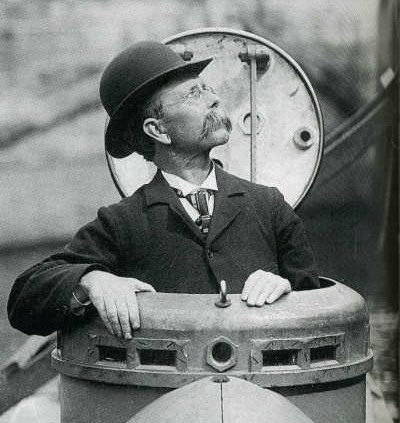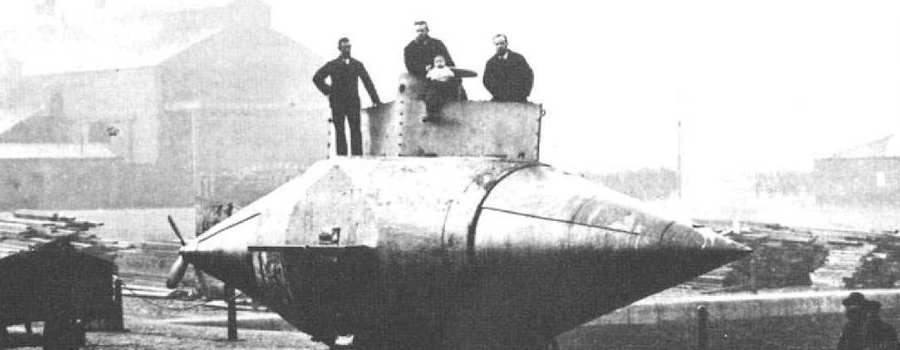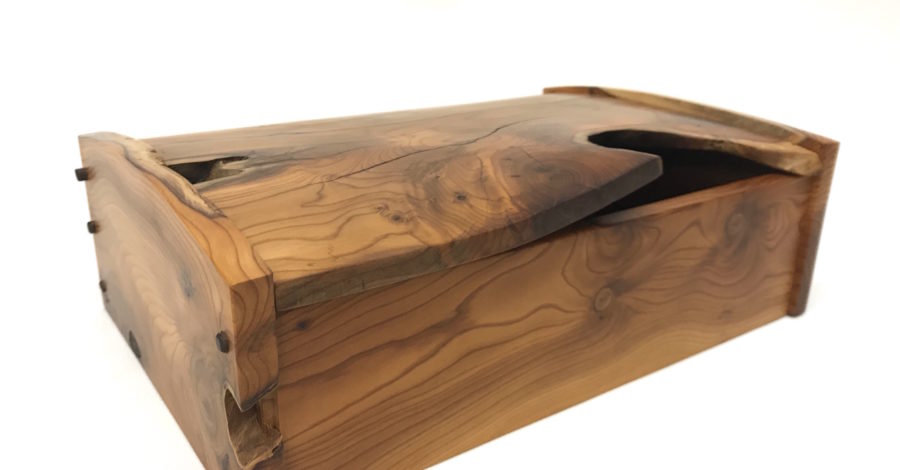
[dropcap type=”circle”]R[/dropcap]esurgam was the brainchild of the Reverend George Garrett, curate of Moss Side in Manchester.
Brilliant, a little eccentric but also level-headed, he realised in the mid-1870’s that submarines could police the British coastline and strike at any menacing Russian ironclads. He could safeguard his country by building the ultimate deterrent of his day – and make his fortune in the process.
Resurgam, betraying Garrett’s clerical background, means “I shall rise again”. The name was to prove bizarrely ironic.

The Reverend’s first submarine, often called ‘the curate’s egg’ because of its shape, was a sort of Victorian X-craft. Water ballast was taken on and then expelled by withdrawing or pushing a cylindrical plunger, a primitive version of ‘blowing the tanks’. In theory the sub would move alongside the hull of an enemy ship, whereupon its crew of one would place his hands in a pair of external leather gauntlets and deploy a magnetic mine. In practise she wasn’t much of a weapon, so Garrett thought again – and thought big.

The result was Resurgam, 45ft long and weighing around 30 tons. Powered by a ‘fireless’ steam engine designed by American engineer Eugene Lamm, she carried three crew members and was to be armed with recently developed fish torpedoes.
At a cost of £1,538 the submarine was constructed in 1879 by Birkenhead shipwright J.T. Cochran. Records claim that early trials went well, even though Garrett on one day was forced to surface next to a passing schooner and ask the skipper for directions back to Liverpool. The captain took one look at the pioneering submariners and promptly told them: “You are the three biggest fools it has ever been my misfortune to encounter.”
He had a point. Conditions on board the sub were nightmarish. The ‘fireless’ engine was sealed in preparation for submerging at an intense heat; space was at a claustrophobic premium; and only when the boat’s candles flickered and died did the crew understand that it was time to surface, open the hatch and let in some fresh air.
Nevertheless, Garrett was sufficiently confident to demonstrate Resurgam to the Royal Navy off Portsmouth. He resolved to steam there – an act of bravado salesmanship that would prove disastrous.
Mr Cochran implored his client to transport the sub by rail, but Garrett wouldn’t budge. Out in Liverpool Bay the propeller shed a blade, forcing Garrett to put in to Rhyl.
For sixteen weeks repairs and modifications were made until at last, at 10pm on a February night in 1880, Resurgam put to sea again. Now, though, she was under tow from a steam yacht called Elphin which Garrett had bought to provide occasional comfort for the submarine’s crew.
Disaster struck when Elphin developed engine trouble, the seas rose and the tow hawser snapped. Resurgam’s hatch, like that of any sub, could not be sealed from the outside. Stationary and rolling in the water she was vulnerable to the sea, and it was not long before she was swamped and disappeared beneath the waves.

The Reverend Garrett’s brainchild was no more and his fledgling submarine company was broke. But he didn’t give up. In partnership with the Swedish tycoon and arms dealer, Thorsten Nordenfelt, Garrett designed submarines for the navies of Sweden, Greece and Turkey, and, it is believed, became the first submarine skipper to launch a fish torpedo.

Another clergyman, John Holland, would soon devise the combination of diesel and electric power that would drive submarines for more than a century. But Garrett’s vision involved only steam and none of these boats was a triumph. Nevertheless, the grateful Turks made the one-time curate one of their navy’s commanders.
But at last, after the wrecking in 1887 of a sub bought by the Tsar of Russia, George Garrett called it a day. The Church would not welcome him back so he resolved to start a new life in America where he made a disastrous investment in a farm ruined quickly by a harsh winter. Next he joined the US Army and, as Corporal Garrett, fought in the Spanish-American War.
Having survived combat his extraordinary life came to an end in New York in the February of 1902. He was just fifty years old and penniless.

In 1995 the wreck of Resurgam was found off the coast of North Wales by a sports diver. He had been enlisted by a trawler skipper whose nets had snagged on a submerged object not marked on any chart.
This important part of the history of the submarine lies in around eighteen metres of water and has taken punishment from both time and the odd collision with passing vessels. Salvage is not an option – iron so long under water is likely to explosively corrode when raised into the air; and the cost of preserving Resurgam, let alone raising her, would be prohibitive. Click or tap here to see underwater footage of the wreck.
Moreover, many marine archaeologists believe that wrecks should be left in their last and therefore natural resting places where they can be visited, studied and interpreted.
Despite her name, Resurgam will never rise again.

























